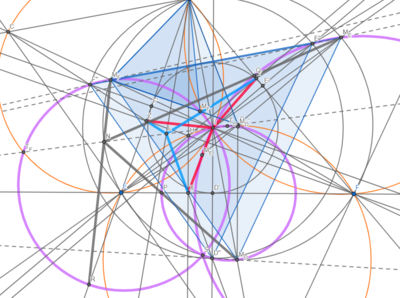Difference between revisions of "2021 JMPSC Sprint Problems/Problem 1"
| Line 18: | Line 18: | ||
- kante314 - | - kante314 - | ||
| + | |||
| + | == Solution 4 == | ||
| + | |||
| + | ''Solution by pog'' | ||
| + | |||
| + | Recall that, for any nonzero <math>a</math>, <math>b</math>, <math>c</math>, we have that <math>\dfrac1a+\dfrac1b+\dfrac1c = \dfrac{\sum_{\text{sym}}ab}{abc}</math>. By Vieta's, we see that <math>a</math>, <math>b</math>, and <math>c</math> are the roots of the monic cubic polynomial <cmath>Q(x) = x^3 - px^2 + \left(\sum_{\text{sym}}ab\right) x - abc,</cmath> where <math>p</math> is an arbitrary constant equal to <math>a + b + c</math>. | ||
| + | |||
| + | In the given equation, we have that <math>a = 3</math>, <math>b = 6</math>, and <math>c = 9</math>, so <math>p = 3 + 6 + 9 = 18</math> and <math>abc = 3 \cdot 6 \cdot 9 = 162</math>, for <cmath>Q(x) = x^3 - 18x^2 + \left(\sum_{\text{sym}}ab\right) x - 162.</cmath> (Finding the former of the latter two coefficients would lead to bashy casework, which we avoid in this extremely elegant solution.) | ||
| + | |||
| + | Since our cubic has roots <math>3</math>, <math>6</math>, and <math>9</math>, the discriminant of our monic cubic polynomial <math>A^2B^2 + 18ABC - 4B^3 - 4A^3C - 27C^2</math> (where <math>A</math>, <math>B</math>, and <math>C</math> are the latter three coefficients of <math>Q(x)</math>, respectively--do not confuse them for the roots of our polynomial equal to <math>a=3</math>, <math>b=6</math>, and <math>c=9</math>, respectively) must not be equal to <math>0</math>, or our cubic will have a double root, which it clearly does not (proof here is left to the reader). | ||
| + | |||
| + | Thus, substitution of the coefficients into our discriminant gives that <math>324 \cdot \left(\sum_{\text{sym}}ab\right)^2 + 324 \left(\sum_{\text{sym}}ab\right) \cdot 162 - 4\left(\sum_{\text{sym}}ab\right)^3 - 4 \cdot 18^3 \cdot 162 - 27 \cdot 162^2</math> must not be equal to <math>0</math>. Letting <math>\sum_{\text{sym}}ab = n</math>, expanding gives that <math>324n^2 + 52488n - 4n^3 - 3779136 - 708588 = -4n^3 + 324n^2 + 52488n - 4487724</math> is not equal to <math>0</math>. Thus <math>n</math> must not be a root of our cubic, so from here we apply the cubic formula to find that <math>n</math> is not equal to (approximately) <math>-115.853202973303</math>, <math>96.4974047104675</math>, or <math>100.355798262835</math>. | ||
| + | |||
| + | Recall that, from earlier, our answer is equal to <math>\left(\dfrac13+\dfrac16+\dfrac19\right)(3 + 6 + 9) = \left(\dfrac1a+\dfrac1b+\dfrac1c\right)(a+b+c) = \left(\dfrac{\sum_{\text{sym}}ab}{162}\right)(18) = \dfrac{n}{162} \cdot 18 = \dfrac{n}{9}</math>. By bounding, <math>n</math> is between the aforementioned values of <math>96.4974047104675</math> and <math>100.355798262835</math>, so since it must be a multiple of <math>9</math> (all answers in the Junior Mathematicians' Problem Solving Competition are integers), it is equal to <math>99</math> and the requested answer is equal to <math>\dfrac{99}{9} = \boxed{11}</math>. This corroborates with jasperE3's strict bounding. <math>\blacksquare</math> | ||
| + | |||
| + | <div style='text-align: center;'>'''Figure 1:''' Final diagram from AoPS user ''awang11'': | ||
| + | [[File:Screen Shot 2021-07-12 at 10.25.44 AM.png||400px]]</div> | ||
==See also== | ==See also== | ||
Latest revision as of 09:53, 12 July 2021
Problem
Compute ![]() .
.
Solution
Solving the right side gives ![]() . Distributing into the left side gives
. Distributing into the left side gives ![]() , so the answer is
, so the answer is ![]() .
.
Solution 2
![]() and
and ![]() , so the answer is
, so the answer is ![]() .
.
Solution 3
![]()
![]()
![]() Therefore, the answer is
Therefore, the answer is ![]()
- kante314 -
Solution 4
Solution by pog
Recall that, for any nonzero ![]() ,
, ![]() ,
, ![]() , we have that
, we have that ![]() . By Vieta's, we see that
. By Vieta's, we see that ![]() ,
, ![]() , and
, and ![]() are the roots of the monic cubic polynomial
are the roots of the monic cubic polynomial ![\[Q(x) = x^3 - px^2 + \left(\sum_{\text{sym}}ab\right) x - abc,\]](http://latex.artofproblemsolving.com/6/e/1/6e1148c9273c109e894d0821ebb95047b81161ac.png) where
where ![]() is an arbitrary constant equal to
is an arbitrary constant equal to ![]() .
.
In the given equation, we have that ![]() ,
, ![]() , and
, and ![]() , so
, so ![]() and
and ![]() , for
, for ![\[Q(x) = x^3 - 18x^2 + \left(\sum_{\text{sym}}ab\right) x - 162.\]](http://latex.artofproblemsolving.com/7/1/1/711b245a00d997eebb80eda90a534e0c9bab92f6.png) (Finding the former of the latter two coefficients would lead to bashy casework, which we avoid in this extremely elegant solution.)
(Finding the former of the latter two coefficients would lead to bashy casework, which we avoid in this extremely elegant solution.)
Since our cubic has roots ![]() ,
, ![]() , and
, and ![]() , the discriminant of our monic cubic polynomial
, the discriminant of our monic cubic polynomial ![]() (where
(where ![]() ,
, ![]() , and
, and ![]() are the latter three coefficients of
are the latter three coefficients of ![]() , respectively--do not confuse them for the roots of our polynomial equal to
, respectively--do not confuse them for the roots of our polynomial equal to ![]() ,
, ![]() , and
, and ![]() , respectively) must not be equal to
, respectively) must not be equal to ![]() , or our cubic will have a double root, which it clearly does not (proof here is left to the reader).
, or our cubic will have a double root, which it clearly does not (proof here is left to the reader).
Thus, substitution of the coefficients into our discriminant gives that  must not be equal to
must not be equal to ![]() . Letting
. Letting ![]() , expanding gives that
, expanding gives that ![]() is not equal to
is not equal to ![]() . Thus
. Thus ![]() must not be a root of our cubic, so from here we apply the cubic formula to find that
must not be a root of our cubic, so from here we apply the cubic formula to find that ![]() is not equal to (approximately)
is not equal to (approximately) ![]() ,
, ![]() , or
, or ![]() .
.
Recall that, from earlier, our answer is equal to ![]() . By bounding,
. By bounding, ![]() is between the aforementioned values of
is between the aforementioned values of ![]() and
and ![]() , so since it must be a multiple of
, so since it must be a multiple of ![]() (all answers in the Junior Mathematicians' Problem Solving Competition are integers), it is equal to
(all answers in the Junior Mathematicians' Problem Solving Competition are integers), it is equal to ![]() and the requested answer is equal to
and the requested answer is equal to ![]() . This corroborates with jasperE3's strict bounding.
. This corroborates with jasperE3's strict bounding. ![]()
See also
The problems on this page are copyrighted by the Junior Mathematicians' Problem Solving Competition. 










